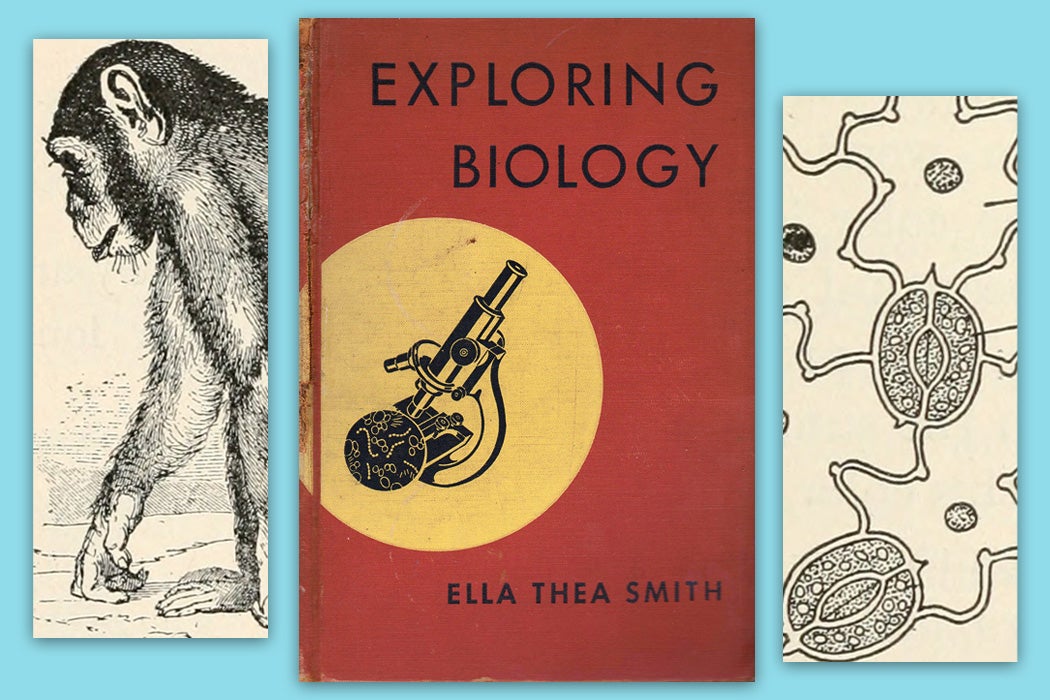In 1925, Tennessee v. Scopes, better known as the Scopes Monkey Trial, captured the attention of the nation. Millions of Americans tuned their radios to listen to the trial of John T. Scopes, a science teacher, who had violated a state law that forbade the teaching of evolution in public schools. After a week-long spectacle, billed as an epic showdown between religion and science, Scopes was found guilty. The law wouldn’t be repealed until 1962.
A series of influential articles published in the 1970s would argue that for a few decades after the Scopes trial, biology textbooks would become “less scientific.” According to these historians, textbook writers and publishers deleted sections about evolution, removed pictures of Darwin, softened “controversial” discussions by weaving in religious quotations, and moved the topic evolution to the last chapter of the textbooks, where it could easily be cut out (sometimes literally, with scissors).
Scholar Ron Ladouceur refers to this popular narrative as the “myth of Scopes,” which he defines as “the conventional belief that the theory of evolution…was fairly presented in high school textbooks prior to the Scopes trial, but that references to the topic were systematically removed by authors and publishers under pressure from Christian fundamentalists over the next 35 years.”
One example often used to support this idea is the work of Ella Thea Smith, author of Exploring Biology, a hugely popular biology textbook. Its 1959 edition used the word “evolution” only once. According to Ladouceur, “scholars saw in Smith evidence of creeping capitulation to American anti-intellectualism.”
In reality, though, Exploring Biology was one of the few books to include extensive treatments of evolution and reproduction. It “was able to simultaneously present the latest science, empower [Smith’s] students, work to counter social injustices, and compete successfully in the commercial textbook market.”
So why was Smith’s work misread? Ladouceur points to the Biological Sciences Curriculum Study (BSCS), which was formed in 1963 to create educational materials. The group would release three influential textbooks, and its chairman “once called Smith’s textbook…’quite outstanding and probably the best among its competitors.'” Smith was invited to join the BSCS steering committee.
But, Ladouceur notes, two years later Smith’s work started being criticized by the BSCS itself. The problem, he argues, was that the BSCS wanted to “promote its own textbooks,” so it “lumped Smith’s together with lesser efforts and criticized the lot.”
Textbooks on the market between 1925 and 1963, however, were more varied than the BSCS let on. “Progressive” textbooks, for example, included good explanations of evolution, but often to promote eugenics. Smith’s textbook stood out as one of the few that “focused on the unity of life, not the progress of life.”
Ladouceur argues that the BSCS constructed its own heroic myth “as part of a public relations effort…to differentiate, defend, and promote its work.”
Weekly Digest
Textbooks are a snapshot of history. Ladouceur writes that the three 1963 BSCS textbooks “have been incorrectly credited for ‘reintroducing’ the topic of evolution into the high school curriculum, and exalted for being more ‘scientific’…than their post-Scopes predecessors.” In Ladouceur’s view, reexamining the work of Ella Thea Smith helps reconstruct the true history of the treatment of evolution in twentieth-century biology textbooks.







